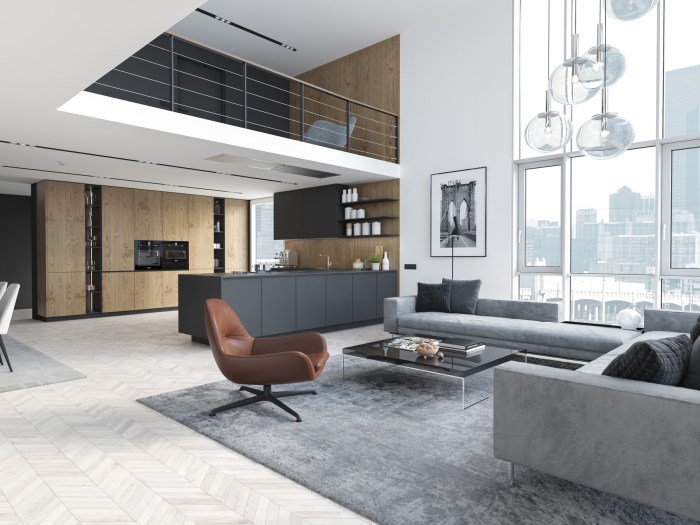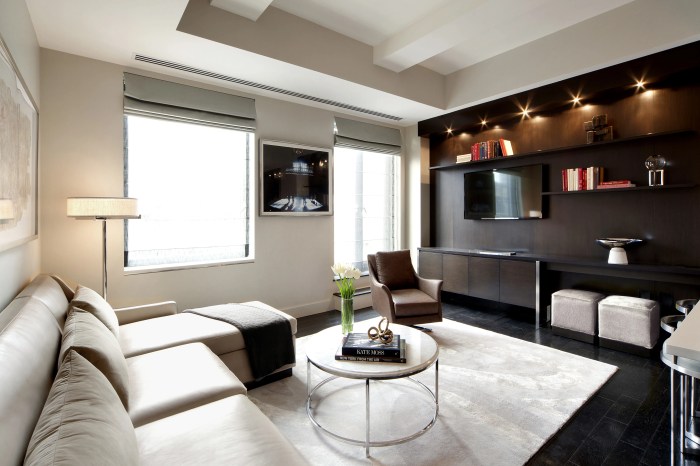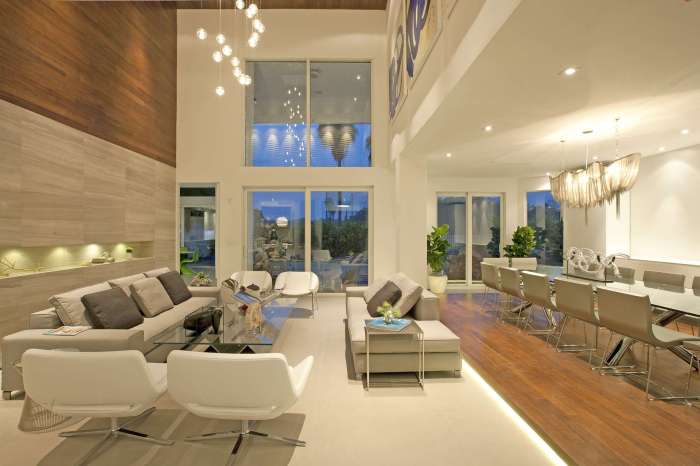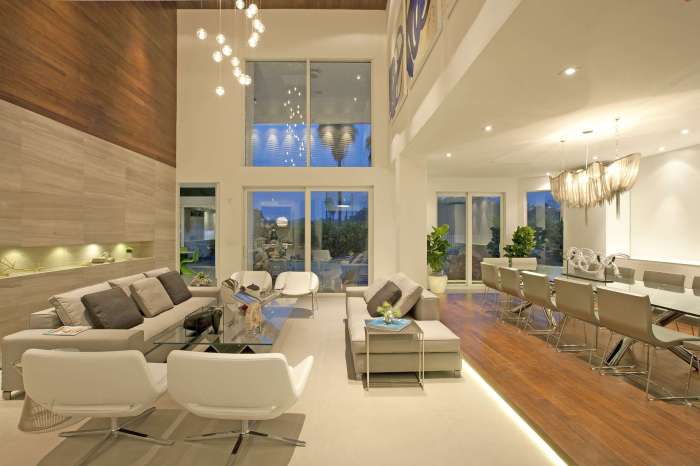Contemporary house design interior embodies a timeless elegance and functionality, embracing clean lines, natural light, and a focus on open spaces. It transcends fleeting trends, creating a lasting impression with its sophisticated minimalism and seamless integration of modern technology.
This style goes beyond mere aesthetics, offering a lifestyle that prioritizes comfort, efficiency, and a harmonious connection with the environment. It seamlessly blends natural materials with cutting-edge technology, resulting in homes that are both visually stunning and incredibly livable.
Defining Contemporary House Design

Contemporary house design is a popular architectural style that emphasizes clean lines, open floor plans, and a focus on natural light. It often incorporates sustainable materials and energy-efficient features, reflecting a modern approach to living.
Contemporary Design Principles
Contemporary design is characterized by several key principles that distinguish it from other architectural styles. These principles include:
- Simplicity and Clean Lines:Contemporary homes often feature simple, geometric shapes and clean lines, avoiding unnecessary ornamentation or embellishments. This creates a sense of order and tranquility.
- Open Floor Plans:Contemporary homes typically have open floor plans that seamlessly connect living spaces, blurring the lines between different areas. This promotes a sense of openness and flow.
- Natural Light:Large windows and skylights are common features in contemporary homes, maximizing natural light and creating a bright and airy atmosphere.
- Sustainable Materials:Contemporary design often prioritizes the use of sustainable materials such as bamboo, reclaimed wood, and recycled materials. This reflects a commitment to environmental responsibility.
- Minimalist Aesthetics:Contemporary homes often embrace a minimalist aesthetic, with a focus on functionality and simplicity. This means avoiding clutter and unnecessary furnishings.
Differences from Other Styles
Contemporary design is often confused with other styles, such as modern and minimalist. However, there are key differences:
- Modern:Modern design emerged in the early 20th century and emphasizes functionality and geometric forms. While contemporary design shares some similarities with modern, it is more flexible and adaptable to current trends.
- Minimalist:Minimalist design is characterized by a focus on simplicity and functionality, with a stark and uncluttered aesthetic. Contemporary design, while often incorporating minimalist elements, can be more expressive and incorporate a wider range of materials and textures.
Iconic Contemporary Homes
Several iconic contemporary homes showcase the defining features of this architectural style.
- Fallingwater (Frank Lloyd Wright, 1935):This iconic home is built over a waterfall, showcasing Wright’s innovative use of natural elements and integration with the surrounding landscape.
- The Farnsworth House (Mies van der Rohe, 1951):This minimalist home is characterized by its glass walls and open floor plan, highlighting the relationship between the interior and exterior spaces.
- The Case Study Houses (Various Architects, 1945-1966):This series of experimental homes in Los Angeles explored new materials and construction techniques, showcasing the innovative spirit of contemporary design.
Contemporary Kitchen Design

The contemporary kitchen is a space that seamlessly blends functionality and aesthetics, reflecting the modern lifestyle. It’s a hub for culinary creativity, social gatherings, and everyday living. Contemporary kitchens prioritize clean lines, minimalist design, and the use of high-quality materials.
Kitchen Layouts
Contemporary kitchens often feature open layouts that integrate seamlessly with the living or dining areas, promoting a sense of spaciousness and flow. Popular layouts include:
- Open Kitchen:This layout breaks down walls between the kitchen and adjacent spaces, creating a unified and social atmosphere.
- Island Layout:A central island serves as a focal point, providing additional counter space, seating, and storage.
- Galley Kitchen:This efficient layout features parallel countertops and appliances, maximizing space in smaller kitchens.
Appliances and Cabinetry
Contemporary kitchens are equipped with advanced appliances that enhance functionality and aesthetics.
- Smart Appliances:These appliances offer connectivity, allowing for remote control and monitoring. Examples include smart refrigerators with touchscreens, ovens with built-in Wi-Fi, and dishwashers with automatic cycles.
- Stainless Steel Appliances:Stainless steel remains a popular choice for contemporary kitchens, offering a sleek and modern look. It’s also durable and easy to clean.
- Cabinetry:Contemporary cabinets often feature clean lines, minimalist hardware, and a focus on functionality. Popular materials include wood, laminate, and acrylic.
Backsplash Design
The backsplash is a key element in contemporary kitchen design, adding a touch of personality and visual interest.
- Tile:Subway tiles, with their rectangular shape and clean lines, are a classic choice for contemporary kitchens. They offer a variety of colors and finishes, allowing for customization.
- Stone:Natural stone, such as marble or granite, brings a touch of elegance and sophistication to the kitchen. Its unique veining and patterns add visual interest.
- Metal:Metal backsplashes, like stainless steel or copper, create a modern and industrial look. They reflect light and add a touch of warmth to the space.
Sustainable Design in Contemporary Homes: Contemporary House Design Interior
Contemporary homes are increasingly embracing sustainable design principles, reflecting a growing awareness of environmental responsibility and a desire to create homes that are both stylish and eco-friendly. Sustainable design goes beyond aesthetics, incorporating practices that minimize the environmental impact of a home throughout its lifecycle.
Contemporary house design interiors often prioritize open floor plans and minimalist aesthetics, creating a sense of spaciousness and tranquility. This approach can also be applied to the design of communal spaces, like a club house interior design , where a welcoming and inviting atmosphere is crucial.
By incorporating elements like natural light, clean lines, and functional furniture, contemporary design principles can enhance the overall experience of any space, whether it’s a private residence or a shared community hub.
Energy Efficiency
Energy efficiency is a cornerstone of sustainable design, aiming to reduce energy consumption and lower utility bills.
- High-Performance Insulation:Contemporary homes often feature thick insulation in walls, roofs, and floors, creating a thermal barrier that minimizes heat loss in winter and heat gain in summer. This reduces reliance on heating and cooling systems, lowering energy consumption.
- Energy-Efficient Windows:Double- or triple-paned windows with low-E coatings help regulate temperature by reducing heat transfer. These windows minimize solar heat gain in summer and heat loss in winter, contributing to energy savings.
- Smart Home Technology:Integrating smart thermostats, lighting controls, and appliance automation allows for precise temperature and lighting adjustments, reducing energy waste. These systems can learn usage patterns and optimize energy consumption based on occupancy and time of day.
Eco-Friendly Materials
Contemporary homes are incorporating a wide range of eco-friendly materials that are sustainable, durable, and aesthetically pleasing.
- Recycled Materials:Utilizing recycled materials like reclaimed wood, recycled glass, and recycled plastic reduces the demand for virgin resources and minimizes landfill waste. These materials often have unique textures and character, adding visual interest to contemporary interiors.
- Locally Sourced Materials:Sourcing materials locally reduces transportation distances and associated emissions. This practice also supports local economies and promotes regional sustainability.
- Sustainable Wood:Selecting wood certified by organizations like the Forest Stewardship Council (FSC) ensures that timber is harvested responsibly and sustainably. This helps protect forests and ensures long-term wood supply.
Sustainable Features
Contemporary homes often incorporate innovative features that enhance their sustainability and reduce their environmental footprint.
- Solar Panels:Photovoltaic solar panels convert sunlight into electricity, reducing reliance on the grid and lowering carbon emissions. Solar panels can be integrated into the roof or façade, seamlessly blending with the contemporary design aesthetic.
- Rainwater Harvesting:Systems for collecting and storing rainwater can be used for irrigation, flushing toilets, and other non-potable water uses. Rainwater harvesting reduces reliance on municipal water supplies and conserves precious water resources.
- Green Roofs:Planting vegetation on rooftops provides numerous benefits. Green roofs improve insulation, reduce stormwater runoff, and create a habitat for wildlife. They also enhance the visual appeal of the home and contribute to urban green spaces.
Benefits of Sustainable Design
Incorporating sustainable design principles in contemporary homes offers a multitude of benefits:
- Reduced Energy Costs:Energy-efficient features and appliances significantly lower energy consumption, resulting in substantial savings on utility bills.
- Lower Environmental Impact:Sustainable design minimizes the home’s carbon footprint by reducing energy consumption, waste generation, and reliance on non-renewable resources.
- Improved Indoor Air Quality:Utilizing natural materials and ventilation systems promotes better indoor air quality, creating a healthier and more comfortable living environment.
- Increased Property Value:Homes with sustainable features are often more desirable and command higher resale values, reflecting the growing demand for environmentally conscious living.
Technology Integration in Contemporary Homes

Technology plays a crucial role in shaping the modern living experience, seamlessly integrating into contemporary homes to enhance comfort, security, and efficiency. Smart home systems, home automation, and advanced entertainment systems are transforming how we interact with our living spaces, creating a more connected and convenient lifestyle.
Smart Home Systems
Smart home systems utilize interconnected devices and sensors to automate and control various aspects of a home, from lighting and temperature to security and entertainment. These systems offer convenience, efficiency, and increased control over daily living.
- Voice Control:Voice assistants like Amazon Alexa and Google Assistant allow homeowners to control lights, appliances, and entertainment systems using voice commands, creating a hands-free experience.
- Remote Access:Smart home systems enable remote control of home functions through smartphones or tablets, allowing homeowners to adjust the thermostat, lock doors, or monitor security cameras while away from home.
- Energy Efficiency:Smart thermostats learn user preferences and adjust heating and cooling schedules automatically, optimizing energy consumption and reducing utility bills.
Home Automation
Home automation takes smart home technology a step further, automating tasks and routines for increased convenience and efficiency.
- Automated Lighting:Smart lighting systems adjust brightness and color temperature based on time of day, activity, or user preferences, creating optimal lighting conditions throughout the day.
- Security Systems:Smart security systems integrate motion sensors, door and window sensors, and cameras to detect and alert homeowners of potential threats, enhancing home security.
- Automated Appliances:Smart appliances like refrigerators, ovens, and washing machines can be controlled remotely, allowing homeowners to preheat ovens, check food inventory, or start laundry cycles from anywhere.
Entertainment Systems
Contemporary homes often feature advanced entertainment systems that offer immersive and personalized experiences.
- Multi-Room Audio:Smart speakers and multi-room audio systems allow homeowners to play music in different rooms, creating a cohesive and personalized listening experience.
- Home Theater Systems:Home theater systems with large-screen televisions, surround sound systems, and advanced audio-visual components create a cinematic experience within the home.
- Streaming Services:Smart TVs and streaming devices provide access to a vast library of movies, TV shows, and music, offering a wide range of entertainment options.
Contemporary Home Office
A contemporary home office can be designed to maximize productivity and organization by incorporating smart technology.
- Smart Desk:A smart desk with integrated power outlets, USB ports, and wireless charging pads provides a convenient and organized workspace.
- Video Conferencing:A high-quality webcam and microphone allow for seamless video conferencing and online meetings.
- Digital Organization:Cloud-based storage services and digital document management systems help streamline document organization and collaboration.
Contemporary House Design in Different Climates
Contemporary house design adapts to diverse climates, utilizing specific materials and features to optimize comfort, energy efficiency, and sustainability. This approach ensures that homes seamlessly integrate with their surroundings, creating harmonious living spaces that respond to the unique challenges and opportunities presented by each climate.
Contemporary House Design in Tropical Climates
Tropical climates are characterized by high temperatures, humidity, and abundant rainfall. Contemporary house design in these regions focuses on maximizing ventilation and natural light while minimizing heat gain.
- Open Floor Plans:Open floor plans promote cross-ventilation, allowing air to circulate freely throughout the house. This reduces reliance on air conditioning and creates a more comfortable indoor environment.
- High Ceilings:High ceilings allow hot air to rise, creating a natural convection effect that draws cool air in from below. This helps to maintain a comfortable temperature even in hot and humid conditions.
- Overhangs and Roof Extensions:Overhangs and roof extensions provide shade from the sun, reducing heat gain and protecting interior spaces from direct sunlight. This minimizes the need for artificial cooling and contributes to energy efficiency.
- Light-Colored Materials:Light-colored materials, such as white paint or stucco, reflect sunlight and reduce heat absorption. This helps to keep the interior cool and minimizes the need for air conditioning.
- Green Roofs:Green roofs provide insulation, reduce heat gain, and contribute to a sustainable design approach. The vegetation on a green roof absorbs rainwater and helps to regulate the temperature of the building.
Contemporary House Design in Temperate Climates
Temperate climates experience distinct seasons with varying temperatures and rainfall patterns. Contemporary house design in these regions focuses on balancing thermal comfort, energy efficiency, and natural light.
- Passive Solar Design:Passive solar design utilizes the sun’s energy to heat the house in winter and cool it in summer. This involves strategic window placement, overhangs, and thermal mass materials.
- Insulation and Airtightness:Proper insulation and airtightness are crucial for maintaining comfortable temperatures year-round. This reduces heat loss in winter and heat gain in summer, minimizing reliance on heating and cooling systems.
- Double-Glazed Windows:Double-glazed windows provide excellent insulation, reducing heat loss in winter and heat gain in summer. They also improve noise reduction and enhance energy efficiency.
- Materials with High Thermal Mass:Materials such as concrete, stone, and brick have high thermal mass, which means they absorb and store heat. This helps to regulate temperatures inside the house, providing a more comfortable and energy-efficient living space.
Contemporary House Design in Arid Climates
Arid climates are characterized by low humidity, high temperatures, and limited rainfall. Contemporary house design in these regions focuses on maximizing thermal comfort, minimizing water use, and creating a sustainable living environment.
- Passive Cooling Strategies:Passive cooling strategies, such as shading, ventilation, and evaporative cooling, are essential for creating a comfortable living environment in arid climates.
- Xeriscaping:Xeriscaping involves using drought-tolerant plants and landscaping techniques to minimize water use. This helps to conserve water and create a sustainable landscape.
- Water-Efficient Fixtures:Water-efficient fixtures, such as low-flow showerheads and toilets, help to conserve water and reduce the environmental impact of the house.
- Light-Colored Roofs:Light-colored roofs reflect sunlight and reduce heat gain, minimizing the need for air conditioning.
Key Considerations for Contemporary House Design in Various Climates, Contemporary house design interior
| Climate | Key Considerations |
|---|---|
| Tropical | Maximizing ventilation, natural light, and minimizing heat gain. |
| Temperate | Balancing thermal comfort, energy efficiency, and natural light. |
| Arid | Maximizing thermal comfort, minimizing water use, and creating a sustainable living environment. |
The Evolution of Contemporary House Design
Contemporary house design, with its emphasis on clean lines, open spaces, and a focus on functionality, has evolved significantly over the past century. Its roots can be traced back to various historical movements and trends, and its evolution reflects changing lifestyles, technological advancements, and the evolving relationship between humans and the built environment.
Influences and Trends
The emergence of contemporary house design can be attributed to a confluence of influences, including the Bauhaus movement, the International Style, and the rise of modernism in architecture. These movements emphasized simplicity, functionality, and the use of new materials, laying the groundwork for the development of contemporary design principles.
- The Bauhaus Movement (1919-1933): Founded in Germany, the Bauhaus movement championed a unified approach to design, integrating art, craft, and technology. It emphasized functionality, simplicity, and the use of industrial materials, which influenced the development of contemporary house design.
- The International Style (1920s-1930s): Characterized by its use of steel, glass, and concrete, the International Style emphasized clean lines, open spaces, and a focus on functionality. It was particularly influential in the development of modern architecture and contemporary house design.
- Modernism in Architecture (1920s-1960s): Modernist architecture, with its emphasis on functionality, simplicity, and the use of new materials, played a significant role in shaping contemporary house design. It sought to break away from traditional architectural styles and create buildings that were both functional and aesthetically pleasing.
Evolution of Contemporary House Design
Contemporary house design has undergone significant evolution over the years, reflecting changing lifestyles, technological advancements, and evolving design philosophies.
- Mid-Century Modernism (1950s-1960s): This period saw the rise of iconic architects like Frank Lloyd Wright, Mies van der Rohe, and Le Corbusier, who designed homes characterized by open floor plans, large windows, and a focus on natural light.
- Postmodernism (1960s-1990s): Postmodern architecture reacted against the perceived sterility of modernism, introducing elements of ornamentation, playful forms, and a focus on historical references. This influenced contemporary house design, leading to more eclectic and expressive designs.
- Contemporary Design (1990s-Present): Contemporary design continues to evolve, embracing new materials, technologies, and sustainability principles. It emphasizes functionality, simplicity, and a connection with the natural environment.
Key Architects and Designers
Numerous architects and designers have contributed to the development of contemporary house design, each bringing their unique perspectives and innovations.
- Frank Lloyd Wright (1867-1959): A pioneer of modern architecture, Wright’s designs emphasized organic architecture, a harmonious relationship between buildings and their natural surroundings.
- Mies van der Rohe (1886-1969): Known for his minimalist approach, van der Rohe’s designs emphasized clean lines, open spaces, and the use of steel and glass.
- Le Corbusier (1887-1965): A key figure in the International Style, Corbusier’s designs emphasized functionality, simplicity, and the use of concrete.
- Philip Johnson (1906-2005): A prolific architect, Johnson’s work embraced both modern and postmodern styles, contributing to the diversity of contemporary house design.
- Zaha Hadid (1950-2016): A renowned architect, Hadid’s designs were characterized by their fluid forms, dynamic curves, and use of advanced technology.
Closing Summary
Exploring contemporary house design interior reveals a captivating fusion of form and function. It invites us to envision homes that are not just spaces to live in, but rather carefully curated environments that reflect our values and aspirations. By embracing the principles of this style, we can create living spaces that are both beautiful and inspiring, fostering a sense of tranquility and effortless elegance.
Answers to Common Questions
What are the key differences between contemporary and modern design?
While both styles share a focus on clean lines and functionality, contemporary design is more fluid and incorporates elements of the past, while modern design adheres to stricter, geometric principles.
How can I incorporate contemporary design into my existing home?
Start by incorporating key elements like open floor plans, natural light, and clean lines. You can introduce contemporary furniture, lighting, and artwork to create a cohesive look.
What are some popular contemporary color palettes?
Neutral palettes like white, gray, and black are popular, often accented with pops of color in blues, greens, or yellows. Natural wood tones also play a significant role.
Is contemporary design suitable for small spaces?
Absolutely! The use of light colors, open floor plans, and minimalist furniture can actually make small spaces feel larger and more inviting.

